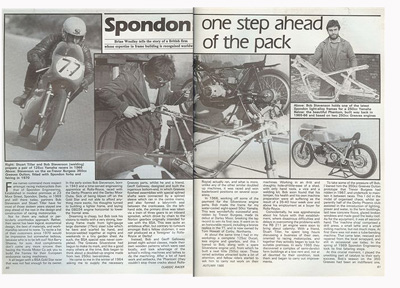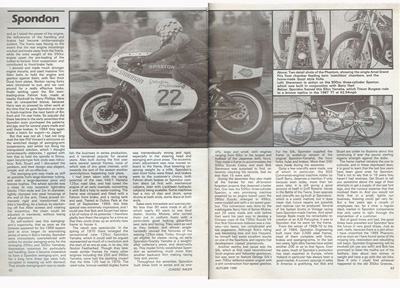

Spondon is actually the name of a village in Derbyshire, England. It was there in 1969 that Bob Stevenson and Stuart Tiller got together to start their motorcycle engineering business. In the mid 1960s, when BSA Gold Stars were still useable for club racing, Stevenson figured he could improve things by manufacturing his own frame. The BSA project never really eventuated, but when Stevenson began working with a custom chassis and a Greeves engine, things really took off.
Disatisfied with his engineering job at Rolls Royce, Stevenson teamed up with good friend, Stuart Tiller. One of their very early success stories involved a custom chassis for Yamaha’s 125cc engine in the early 70s. Soon there were chassis’ for 250cc and 350cc machines, culminating in Germany’s Martin Wimmer winning the 1982 British 250cc GP Championship on a Spondon framed Yamaha. There were numerous British Championship wins for Spondon in those days too, and even Barry Sheene had a Spondon connection.
This connection to road racing is crucial to the Spondon story. A similar situation in some ways to Bimota, who also manufactured chassis for GP racers in the 70s and early 80s. Whereas the Italian specialists had begun working with road bikes by the mid-1980s, it took Spondon until the end of the decade and as Stevenson himself explained in an open and friendly phone conversation;
"We did have a number of one-off beam frames for road bikes made by the mid-80s, but by the start of the 90s it was clear that people weren’t going to throw their Japanese GP frames away any more because they were by now so good. Obviously we had to find another avenue."
By this stage Spondon had of course become involved in the Norton rotary project, supplying the huge - but light - beam section frame for the F1. They were glorious days for UK racing too, with Steve Spray, Trevor Nation and Robert Dunlop all scoring wins for the resurrected Norton marque. The Roton that evolved from the F1 Norton (we’ll leave the intense political situation associated with that one well alone!) continued the Spondon success story, with Ian Simpson winning back-to-back British F1 Championships in 1994 and 1995.
While all of this road racing was going on in full public view, Spondon were busy jigging up and manufacturing frames for a variety of road bike engines. Nothing is mass produced at Spondon, but chances are that if you want a chassis for a GSX 1100 motor or a GSX-R1100, the English frame specialists can find the appropriate jigs and perform their acts of wizardry. Remember too, that a Spondon chassis carries more than twenty years of racing heritage, so lightness and absoloute rigidity are fundamental features, even with their road bike chassis. It’s interesting to note that, while Spondon have made beam style chassis in the past, their main focus today is on tube construction - for good reason.
"Our customers want something that looks completely different to what comes off the production lines in Japan and Italy," said Stevenson. "There’s also the subtle fact that tube frames hark back to a classic era, but we can now manufacture them to very modern standards." These chassis were welded together from aluminium round tube to 7020 T6 TF condition and T.I.G welded in accordance with specifications EN 288-4. Spondon’s GSX-R chassis has recently been granted Germany’s T.U.V approval and the Fireblade chassis, manufactured to the exact same standard, is soon to follow suit.
TAKEN FROM
'THE SPONDON FILES'
OFF
'RICK'S CUSTOM SHED'
WEBSITE

